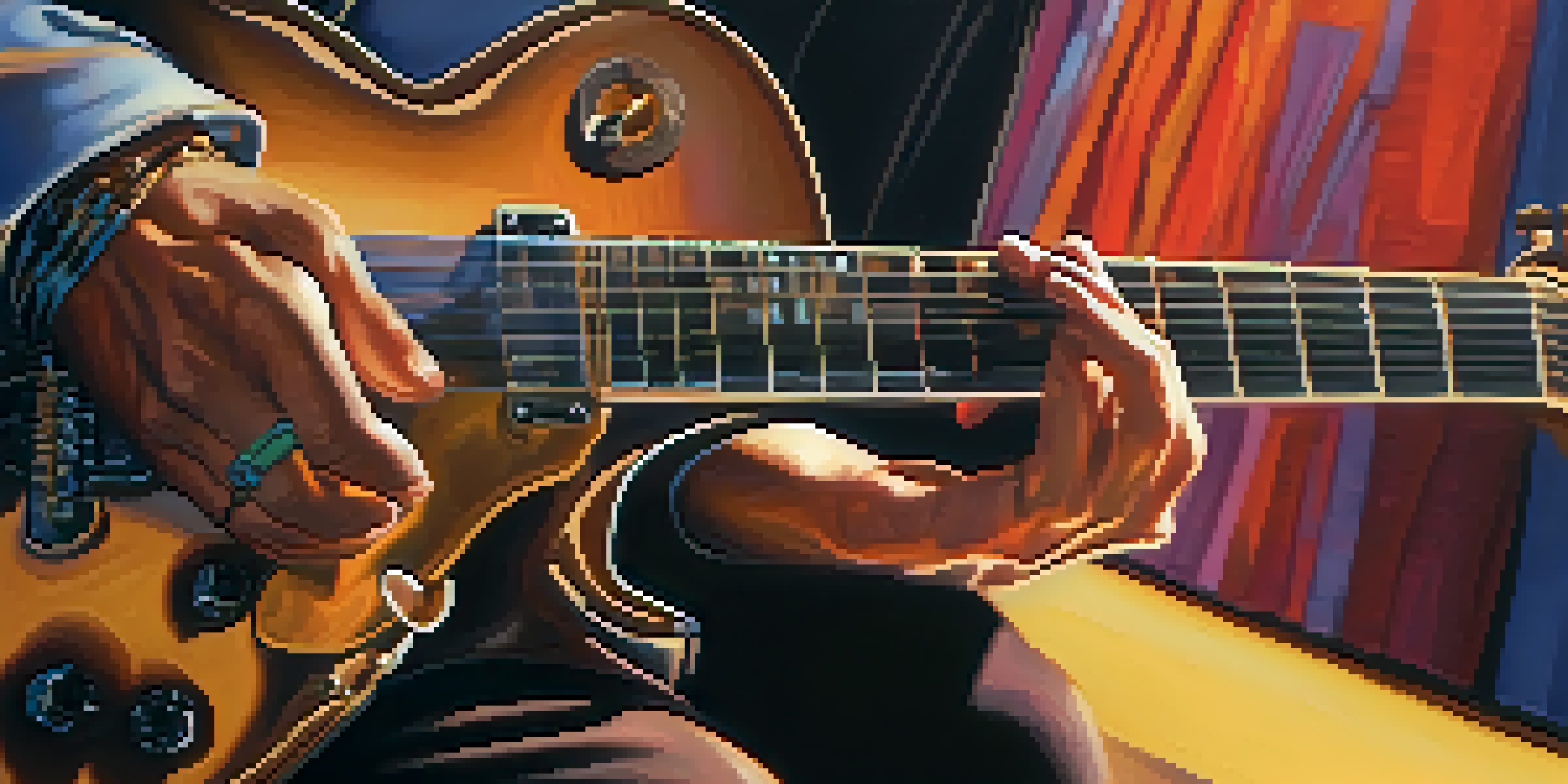Guitar Modes: How to Apply Them in Your Improvisation Skills

Understanding Guitar Modes and Their Importance
Guitar modes are variations of scales that provide different emotional flavors to your playing. Each mode has its own unique sound, making them invaluable for improvisation. By understanding these modes, you can break free from the usual scale patterns and explore new musical landscapes.
Music is the shorthand of emotion.
For instance, the Dorian mode has a jazzy feel, while the Phrygian mode can evoke a more exotic sound. This variety allows you to express different emotions and connect with your audience on a deeper level. Recognizing the significance of modes can transform your approach to creating music.
Moreover, using modes can help you navigate chord progressions with ease. Instead of sticking to the same few notes, you can incorporate modes to add flavor and complexity to your solos. This not only makes your improvisation sound richer but also showcases your creativity as a musician.
The Seven Essential Guitar Modes Explained
There are seven main modes derived from the major scale: Ionian, Dorian, Phrygian, Lydian, Mixolydian, Aeolian, and Locrian. Each mode starts on a different degree of the scale, which changes the overall mood and characteristics of the sound. By familiarizing yourself with these modes, you'll have a toolkit to enhance your improvisational skills.

For example, the Ionian mode is simply the major scale, bright and uplifting, while the Locrian mode is often considered the most unstable and dissonant. Understanding these differences allows you to choose the right mode based on the song's context or the emotion you want to convey. It’s like having a palette of colors to paint your musical picture.
Unlock Creativity with Modes
Guitar modes offer unique emotional flavors, allowing musicians to break free from standard scales and enhance their improvisation.
As you explore these modes, try playing them over backing tracks or chord progressions. This practice will help you internalize their sounds and see how they fit into different musical situations. Each mode can unlock a new dimension of creativity, enhancing your overall playing.
Practicing Modes: Exercises to Get Started
To effectively incorporate modes into your improvisation, practice is key. Start by playing each mode in different positions on the fretboard. This will help you become familiar with their unique sounds and finger placements, making it easier to access them when improvising.
The great thing about music is that you can always change it, and it will always be a reflection of who you are and where you are in life.
A great exercise is to take a common chord progression and play different modes over it. For example, if you're playing a C major chord progression, try using the Ionian mode first, then switch to Dorian or Mixolydian. This will help you hear how each mode interacts with the chords and allows you to discover new melodic ideas.
Additionally, consider recording yourself while experimenting with modes. Listening back can provide insights into areas where you shine and where you may need improvement. This feedback loop can be incredibly beneficial as you refine your improvisation skills.
Applying Modes to Common Chord Progressions
Understanding how to apply modes to chord progressions is crucial for effective improvisation. Many songs are built on simple progressions, and knowing which mode to use can elevate your solos dramatically. For example, if a progression is in A minor, using the Aeolian mode will resonate well with the chords.
Another common progression is the I-IV-V, where each chord can suggest a different mode. For instance, over a C major (I), F major (IV), and G major (V), you could use the Ionian mode for C, the Lydian mode for F, and the Mixolydian mode for G. This approach not only sounds sophisticated but also keeps your improvisation fresh.
Practice Modes on Chord Progressions
Incorporating modes over common chord progressions can elevate solos and reveal new melodic ideas.
By analyzing songs that you enjoy, you can notice how different artists utilize modes. Try to identify which mode fits with each section of the song and then experiment using that mode in your own playing. This practice will deepen your understanding of modes and their application in real-world music.
Improvising with Modes: Tips for Success
When improvising with modes, it’s important to stay relaxed and open-minded. Allow yourself the freedom to explore different melodic ideas without worrying about perfection. This mindset fosters creativity and can lead to unexpected musical moments that elevate your playing.
One helpful tip is to focus on the chord tones of the progression while using the mode. This means emphasizing the notes that are part of the chords, which creates a strong sense of harmony. By doing this while incorporating the unique notes from the mode, you can create compelling solos that are both interesting and musically satisfying.
Additionally, try to listen to how other musicians use modes in their improvisation. Whether it’s a jazz guitarist or a rock soloist, observing their techniques can provide inspiration. Ultimately, the more you practice and experiment, the more confident you’ll become in using modes to enhance your improvisational skills.
Common Mistakes to Avoid When Using Modes
As you delve into modes, it’s easy to fall into some common pitfalls. One major mistake is sticking to only one mode for an entire piece, which can lead to monotonous playing. Instead, embrace the idea of switching modes to add variety and maintain listener interest.
Another mistake is neglecting the underlying chord changes. Failing to recognize how modes interact with chords can result in dissonance or a lack of connection in your improvisation. Always keep the chord progressions in mind and choose your modes accordingly to ensure a cohesive sound.
Avoid Common Pitfalls with Modes
To effectively use modes, musicians should avoid sticking to a single mode, neglecting chord changes, and rushing the learning process.
Lastly, don’t rush the learning process. Mastering modes takes time and practice, so be patient with yourself. Embrace each step of the journey, and celebrate your progress as you become more comfortable with applying modes in your improvisation.
Resources for Further Learning About Guitar Modes
To enhance your understanding of guitar modes, there are plenty of resources available. Online platforms offer video tutorials, courses, and articles that break down the intricacies of modes and how to apply them. These resources can be incredibly helpful for visual learners who benefit from seeing concepts in action.
Books on music theory and guitar technique can also provide in-depth insights into modes. Look for titles that focus specifically on improvisation and modal theory, as they’ll offer structured exercises to help you practice. A well-rounded approach to learning will solidify your understanding of how to use modes effectively.

Additionally, consider joining online communities or forums where musicians share their experiences and tips regarding modes. Engaging with other guitarists can spark new ideas and provide support as you refine your skills. Remember, learning is a journey, and connecting with others can make it even more rewarding.